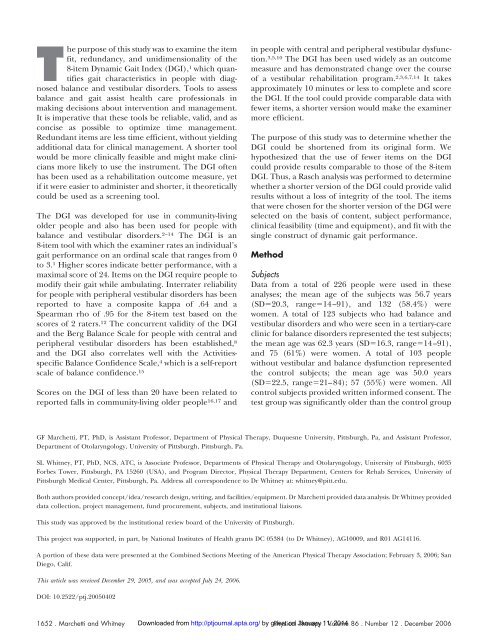Construction and Validation of the 4-Item Dynamic Gait Index
Construction and Validation of the 4-Item Dynamic Gait Index
Construction and Validation of the 4-Item Dynamic Gait Index
You also want an ePaper? Increase the reach of your titles
YUMPU automatically turns print PDFs into web optimized ePapers that Google loves.
The purpose <strong>of</strong> this study was to examine <strong>the</strong> item<br />
fit, redundancy, <strong>and</strong> unidimensionality <strong>of</strong> <strong>the</strong><br />
8-item <strong>Dynamic</strong> <strong>Gait</strong> <strong>Index</strong> (DGI), 1 which quantifies<br />
gait characteristics in people with diagnosed<br />
balance <strong>and</strong> vestibular disorders. Tools to assess<br />
balance <strong>and</strong> gait assist health care pr<strong>of</strong>essionals in<br />
making decisions about intervention <strong>and</strong> management.<br />
It is imperative that <strong>the</strong>se tools be reliable, valid, <strong>and</strong> as<br />
concise as possible to optimize time management.<br />
Redundant items are less time efficient, without yielding<br />
additional data for clinical management. A shorter tool<br />
would be more clinically feasible <strong>and</strong> might make clinicians<br />
more likely to use <strong>the</strong> instrument. The DGI <strong>of</strong>ten<br />
has been used as a rehabilitation outcome measure, yet<br />
if it were easier to administer <strong>and</strong> shorter, it <strong>the</strong>oretically<br />
could be used as a screening tool.<br />
The DGI was developed for use in community-living<br />
older people <strong>and</strong> also has been used for people with<br />
balance <strong>and</strong> vestibular disorders. 2–14 The DGI is an<br />
8-item tool with which <strong>the</strong> examiner rates an individual’s<br />
gait performance on an ordinal scale that ranges from 0<br />
to 3. 1 Higher scores indicate better performance, with a<br />
maximal score <strong>of</strong> 24. <strong>Item</strong>s on <strong>the</strong> DGI require people to<br />
modify <strong>the</strong>ir gait while ambulating. Interrater reliability<br />
for people with peripheral vestibular disorders has been<br />
reported to have a composite kappa <strong>of</strong> .64 <strong>and</strong> a<br />
Spearman rho <strong>of</strong> .95 for <strong>the</strong> 8-item test based on <strong>the</strong><br />
scores <strong>of</strong> 2 raters. 12 The concurrent validity <strong>of</strong> <strong>the</strong> DGI<br />
<strong>and</strong> <strong>the</strong> Berg Balance Scale for people with central <strong>and</strong><br />
peripheral vestibular disorders has been established, 8<br />
<strong>and</strong> <strong>the</strong> DGI also correlates well with <strong>the</strong> Activitiesspecific<br />
Balance Confidence Scale, 4 which is a self-report<br />
scale <strong>of</strong> balance confidence. 15<br />
Scores on <strong>the</strong> DGI <strong>of</strong> less than 20 have been related to<br />
reported falls in community-living older people 16,17 <strong>and</strong><br />
in people with central <strong>and</strong> peripheral vestibular dysfunction.<br />
3,5,10 The DGI has been used widely as an outcome<br />
measure <strong>and</strong> has demonstrated change over <strong>the</strong> course<br />
<strong>of</strong> a vestibular rehabilitation program. 2,3,6,7,14 It takes<br />
approximately 10 minutes or less to complete <strong>and</strong> score<br />
<strong>the</strong> DGI. If <strong>the</strong> tool could provide comparable data with<br />
fewer items, a shorter version would make <strong>the</strong> examiner<br />
more efficient.<br />
The purpose <strong>of</strong> this study was to determine whe<strong>the</strong>r <strong>the</strong><br />
DGI could be shortened from its original form. We<br />
hypo<strong>the</strong>sized that <strong>the</strong> use <strong>of</strong> fewer items on <strong>the</strong> DGI<br />
could provide results comparable to those <strong>of</strong> <strong>the</strong> 8-item<br />
DGI. Thus, a Rasch analysis was performed to determine<br />
whe<strong>the</strong>r a shorter version <strong>of</strong> <strong>the</strong> DGI could provide valid<br />
results without a loss <strong>of</strong> integrity <strong>of</strong> <strong>the</strong> tool. The items<br />
that were chosen for <strong>the</strong> shorter version <strong>of</strong> <strong>the</strong> DGI were<br />
selected on <strong>the</strong> basis <strong>of</strong> content, subject performance,<br />
clinical feasibility (time <strong>and</strong> equipment), <strong>and</strong> fit with <strong>the</strong><br />
single construct <strong>of</strong> dynamic gait performance.<br />
Method<br />
Subjects<br />
Data from a total <strong>of</strong> 226 people were used in <strong>the</strong>se<br />
analyses; <strong>the</strong> mean age <strong>of</strong> <strong>the</strong> subjects was 56.7 years<br />
(SD20.3, range14–91), <strong>and</strong> 132 (58.4%) were<br />
women. A total <strong>of</strong> 123 subjects who had balance <strong>and</strong><br />
vestibular disorders <strong>and</strong> who were seen in a tertiary-care<br />
clinic for balance disorders represented <strong>the</strong> test subjects;<br />
<strong>the</strong> mean age was 62.3 years (SD16.3, range14–91),<br />
<strong>and</strong> 75 (61%) were women. A total <strong>of</strong> 103 people<br />
without vestibular <strong>and</strong> balance dysfunction represented<br />
<strong>the</strong> control subjects; <strong>the</strong> mean age was 50.0 years<br />
(SD22.5, range21–84); 57 (55%) were women. All<br />
control subjects provided written informed consent. The<br />
test group was significantly older than <strong>the</strong> control group<br />
GF Marchetti, PT, PhD, is Assistant Pr<strong>of</strong>essor, Department <strong>of</strong> Physical Therapy, Duquesne University, Pittsburgh, Pa, <strong>and</strong> Assistant Pr<strong>of</strong>essor,<br />
Department <strong>of</strong> Otolaryngology, University <strong>of</strong> Pittsburgh, Pittsburgh, Pa.<br />
SL Whitney, PT, PhD, NCS, ATC, is Associate Pr<strong>of</strong>essor, Departments <strong>of</strong> Physical Therapy <strong>and</strong> Otolaryngology, University <strong>of</strong> Pittsburgh, 6035<br />
Forbes Tower, Pittsburgh, PA 15260 (USA), <strong>and</strong> Program Director, Physical Therapy Department, Centers for Rehab Services, University <strong>of</strong><br />
Pittsburgh Medical Center, Pittsburgh, Pa. Address all correspondence to Dr Whitney at: whitney@pitt.edu.<br />
Both authors provided concept/idea/research design, writing, <strong>and</strong> facilities/equipment. Dr Marchetti provided data analysis. Dr Whitney provided<br />
data collection, project management, fund procurement, subjects, <strong>and</strong> institutional liaisons.<br />
This study was approved by <strong>the</strong> institutional review board <strong>of</strong> <strong>the</strong> University <strong>of</strong> Pittsburgh.<br />
This project was supported, in part, by National Institutes <strong>of</strong> Health grants DC 05384 (to Dr Whitney), AG10009, <strong>and</strong> R01 AG14116.<br />
A portion <strong>of</strong> <strong>the</strong>se data were presented at <strong>the</strong> Combined Sections Meeting <strong>of</strong> <strong>the</strong> American Physical Therapy Association; February 3, 2006; San<br />
Diego, Calif.<br />
This article was received December 29, 2005, <strong>and</strong> was accepted July 24, 2006.<br />
DOI: 10.2522/ptj.20050402<br />
1652 . Marchetti <strong>and</strong> Whitney Downloaded from http://ptjournal.apta.org/ by guest Physical on January Therapy 11, . Volume 2014 86 . Number 12 . December 2006
















